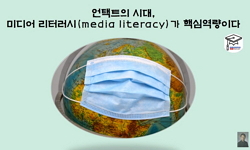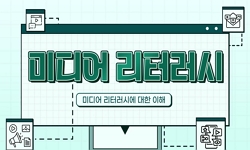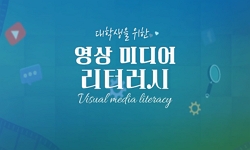This study aimed to investigate the process of developing English literacy skills and English reading interests of primary English learners by using graphic novels for children. For these objectives, the following research questions were set up: 1) wh...
http://chineseinput.net/에서 pinyin(병음)방식으로 중국어를 변환할 수 있습니다.
변환된 중국어를 복사하여 사용하시면 됩니다.
- 中文 을 입력하시려면 zhongwen을 입력하시고 space를누르시면됩니다.
- 北京 을 입력하시려면 beijing을 입력하시고 space를 누르시면 됩니다.
https://www.riss.kr/link?id=A103858022
- 저자
- 발행기관
- 학술지명
- 권호사항
-
발행연도
2017
-
작성언어
-
-
주제어
reading interest ; literacy ; graphic novels ; story books ; 읽기 흥미도 ; 리터러시 ; 그래픽 이야기 ; 이야기책
-
KDC
374
-
등재정보
KCI등재
-
자료형태
학술저널
- 발행기관 URL
-
수록면
131-152(22쪽)
-
KCI 피인용횟수
0
- DOI식별코드
- 제공처
-
0
상세조회 -
0
다운로드
부가정보
다국어 초록 (Multilingual Abstract)
First, this study demonstrated the benefits of using graphic novels that Korean primary teachers were not familiar with. Second, this study offers an effective way to enhance students’ reading interest and analyzed the features of graphic novels which improved students reading interests. Third, this study shows the possibility to combine reading and writing in primary EFL contexts by using the graphic novels.
This study aimed to investigate the process of developing English literacy skills and English reading interests of primary English learners by using graphic novels for children. For these objectives, the following research questions were set up: 1) what are the impacts of graphic novels on primary students’ English reading interests? 2) how do after-reading activities based on graphic novels influence the primary students’ English literacy skills? In an attempt to answer these research questions, this study describes how 25 fourth grade students were taught reading and writing through five graphic novels for 14 weeks. Data from diverse sources were collected and analyzed in a qualitative manner. The data analysis yielded the following results: First, using graphic novels in the English literacy class increased students’ reading interests and led them to read more English books. Second, literacy classes based on graphic novels helped students improve their reading and writing skills. The results of the present research on using graphic novels in an EFL English class have the following implications for primary English education:
First, this study demonstrated the benefits of using graphic novels that Korean primary teachers were not familiar with. Second, this study offers an effective way to enhance students’ reading interest and analyzed the features of graphic novels which improved students reading interests. Third, this study shows the possibility to combine reading and writing in primary EFL contexts by using the graphic novels.
참고문헌 (Reference)
1 권현정, "패턴이 있는 이야기책 기반 초등영어 학습부진학생의 문자언어 지도에 대한 연구" 한국외국어교육학회 19 (19): 143-175, 2012
2 이보리, "초등학교 영어 학습자의 문자 해독 능력, 읽기 유창성 및 흥미도가 독해력에 미치는 영향" 교과교육연구소 18 (18): 703-723, 2014
3 김유민, "전래동화와 패러디 연계 활용을 통한 초등영어 지도 및 비판적 사고력 개발에 대한 연구" 글로벌영어교육학회 21 (21): 175-205, 2016
4 민덕기, "인터넷상의 만화를 이용한 영어 교수-학습방안" 4 (4): 153-166, 1998
5 김혜리, "이야기 기반 활동 중심 초등 영어 수업 개발 및 실행에 대한 연구" 미래영어영문학회 16 (16): 99-132, 2011
6 김창호, "웹상의 만화를 활용한 초등영어 교수 학습" 대한영어영문학회 32 (32): 185-212, 2006
7 교육부, "영어과 교육과정"
8 김혜리, "아동문학 텍스트 기반 질문 전략을 활용한 발화 중심의 초등 영어 수업 실행 연구" 한국영어교과교육학회 12 (12): 29-55, 2013
9 김성필, "시각적 서사물로서 그래픽 노블의 정체성에 관한 연구" 한국일러스아트학회 17 (17): 27-38, 2014
10 김솔, "문학작품을 활용한 초등영어교육에 대한 교사들의 인식 연구" 한국초등영어교육학회 23 (23): 55-83, 2017
1 권현정, "패턴이 있는 이야기책 기반 초등영어 학습부진학생의 문자언어 지도에 대한 연구" 한국외국어교육학회 19 (19): 143-175, 2012
2 이보리, "초등학교 영어 학습자의 문자 해독 능력, 읽기 유창성 및 흥미도가 독해력에 미치는 영향" 교과교육연구소 18 (18): 703-723, 2014
3 김유민, "전래동화와 패러디 연계 활용을 통한 초등영어 지도 및 비판적 사고력 개발에 대한 연구" 글로벌영어교육학회 21 (21): 175-205, 2016
4 민덕기, "인터넷상의 만화를 이용한 영어 교수-학습방안" 4 (4): 153-166, 1998
5 김혜리, "이야기 기반 활동 중심 초등 영어 수업 개발 및 실행에 대한 연구" 미래영어영문학회 16 (16): 99-132, 2011
6 김창호, "웹상의 만화를 활용한 초등영어 교수 학습" 대한영어영문학회 32 (32): 185-212, 2006
7 교육부, "영어과 교육과정"
8 김혜리, "아동문학 텍스트 기반 질문 전략을 활용한 발화 중심의 초등 영어 수업 실행 연구" 한국영어교과교육학회 12 (12): 29-55, 2013
9 김성필, "시각적 서사물로서 그래픽 노블의 정체성에 관한 연구" 한국일러스아트학회 17 (17): 27-38, 2014
10 김솔, "문학작품을 활용한 초등영어교육에 대한 교사들의 인식 연구" 한국초등영어교육학회 23 (23): 55-83, 2017
11 김혜련, "만화를 활용한 초등영어 문자언어 지도의 효과" 한국초등영어교육학회 11 (11): 209-240, 2005
12 김나영, "그림책의 삽화와 텍스트의 상호작용에 대한 이해 기반초등 영어 문자 언어 학습 양상" 한국영어교과교육학회 15 (15): 81-105, 2016
13 Ranker, J., "Using comic books as read‐alouds : Insights on reading instruction from an English as a second language classroom" 61 (61): 296-305, 2007
14 Krashen, S, D., "The power of reading" Heinemann 2004
15 Hidi, S., "The four-phase model of interest development" 41 (41): 111-127, 2006
16 Cho, K. S., "The effects of narrow reading of authentic texts on interest and reading ability in English as a foreign language" 42 (42): 58-64, 2005
17 Williams, N., "The comic book as course book: Why and how" 1995
18 Monnin, K., "Teaching graphic novels: Practical strategies for the secondary ELA classroom" Maupin House Publishing 2010
19 Cho, K. S., "Sustained silent reading experiences among Korean teachers of English as a foreign language : The effect of a single exposure to interesting, comprehensible reading" 38 (38): 170-175, 2001
20 Chase, M., "Sequencing and graphic novels with primary grade students" 67 (67): 435-443, 2014
21 Bernstein, M. R., "Relationship between interest and reading comprehension" 49 (49): 283-288, 1955
22 Estes, T. H., "Reading interest and comprehension : Implications" 27 (27): 149-153, 1973
23 Yamashita, J., "Reading attitudes in L1 and L2, and their influence on L2 extensive reading" 16 : 1-19, 2004
24 Stanovich, K, E., "Matthew effects in reading : some consequences of individual differences in the acquisition of literacy" 21 (21): 360-407, 1986
25 Vardell, S., "Matching books and readers : Selecting literature for English learners" 59 (59): 734-740, 2006
26 Alexander, P. A., "Interrelationship of knowledge, interest, and recall : Assessing a model of domain learning" 87 (87): 559-575, 1995
27 Sadoski, M., "Imagery and text: A dual coding theory of reading and writing" Routledge 2012
28 Karp, J., "Graphic novels in your school library" American Library Association 2012
29 Cimermanova, I., "Graphic novels in foreign language teaching" 2 (2): 85-94, 2014
30 Lapp, D., "Graphic novels : What elementary teachers think about their instructional value" 192 (192): 23-35, 2011
31 Weiner, S., "Faster Than a Speeding Bullet: The Rise of the Graphic Novel: The Rise of the Graphic Novel" NBM Publishing 2012
32 Day, R. R., "Extensive reading in the second language classroom" Ernst Klett Sprachen 1998
33 Dallacqua, A. K. ., "Exploring Literary Devices in Graphic Novels" 89 (89): 365-378, 2012
34 Baker, L., "Dimensions of children's motivation for reading and their relations to reading activity and reading achievement" 34 (34): 452-477, 1999
35 Sabin, R., "Comics, comix & graphic novels: A history of comic art" Phaidon Press Ltd 2001
36 Glesne, C., "Becoming qualitative researchers: An introduction" Pearson Education 2006
37 허선민, "Becoming Critical Readers of Graphic Novels: Bringing Graphic Novels Into Korean Elementary Literacy Lessons" 한국영어교육학회 70 (70): 123-149, 2015
38 Brown, S., "A blended approach to reading and writing graphic stories" 67 (67): 208-219, 2013
동일학술지(권/호) 다른 논문
-
Implementing Action Research to Improve Preparatory English Programs at Universities in Korea
- 한국영어교과교육학회
- Myeong-Hee Seong
- 2017
- KCI등재
-
- 한국영어교과교육학회
- Donghee Shin
- 2017
- KCI등재
-
A Study on the Use of ‘But’ and ‘However’ in Korean EFL College Learners Argumentative Writing
- 한국영어교과교육학회
- HyunMi Sung
- 2017
- KCI등재
-
언어학습자문학 기반 인문주의적 접근에 의한 영어교육의 현황과 전망
- 한국영어교과교육학회
- 박성수(Park, Seong Soo)
- 2017
- KCI등재
분석정보
인용정보 인용지수 설명보기
학술지 이력
| 연월일 | 이력구분 | 이력상세 | 등재구분 |
|---|---|---|---|
| 2028 | 평가예정 | 재인증평가 신청대상 (재인증) | |
| 2022-01-01 | 평가 | 등재학술지 유지 (재인증) |  |
| 2019-01-01 | 평가 | 등재학술지 유지 (계속평가) |  |
| 2016-01-01 | 평가 | 등재학술지 유지 (계속평가) |  |
| 2012-01-01 | 평가 | 등재학술지 선정 (등재후보2차) |  |
| 2011-01-01 | 평가 | 등재후보 1차 PASS (등재후보1차) |  |
| 2009-01-01 | 평가 | 등재후보학술지 선정 (신규평가) |  |
학술지 인용정보
| 기준연도 | WOS-KCI 통합IF(2년) | KCIF(2년) | KCIF(3년) |
|---|---|---|---|
| 2016 | 0.77 | 0.77 | 0.87 |
| KCIF(4년) | KCIF(5년) | 중심성지수(3년) | 즉시성지수 |
| 0.78 | 0.81 | 1.48 | 0.17 |




 KCI
KCI 스콜라
스콜라






